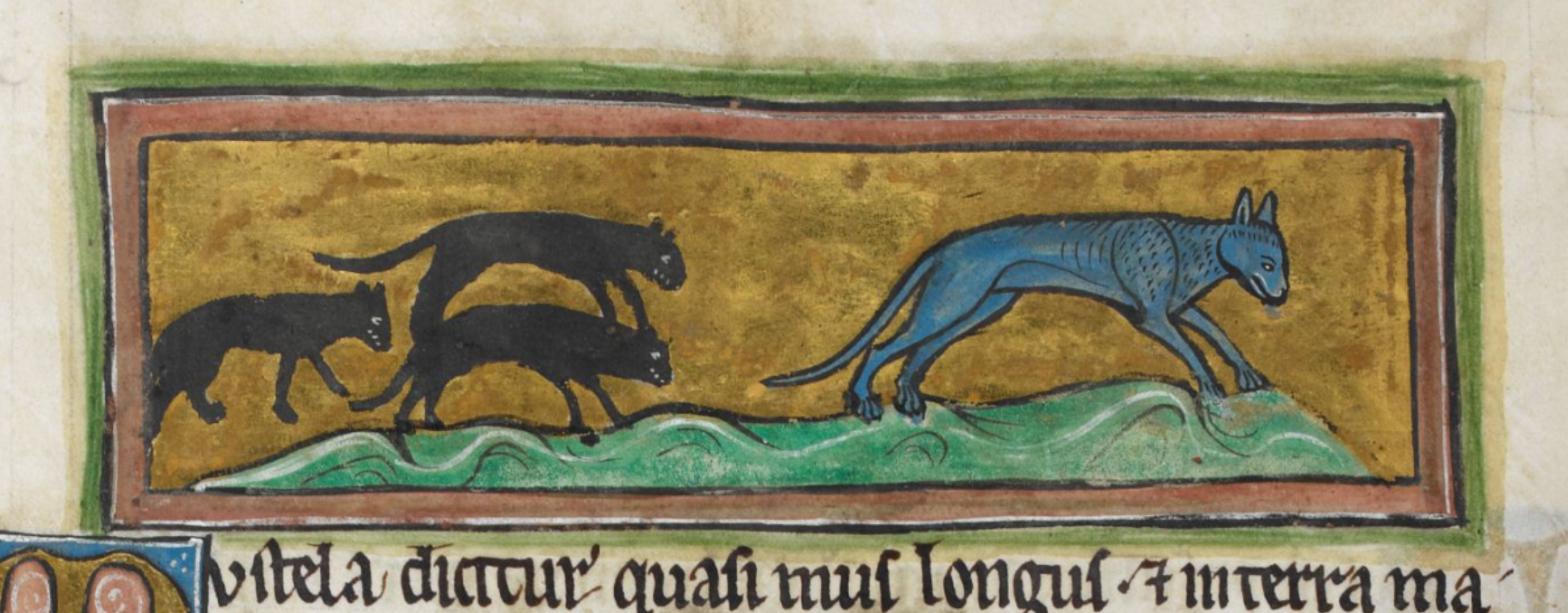
Mouse, Rochester Bestiary, c.1230
Search page
Search within this page here, search the collection page or search the website.
Index
Cat, Rochester Bestiary, c.1230
Weasel, Rochester Bestiary, c.1230
Mouse, Rochester Bestiary, c.1230
The humble mouse scampers into the spotlight, bearing secrets and mysteries that defy its diminutive size. Born from the very moisture of the earth, it dances in harmony with the lunar cycle, its liver swelling under the full moon's radiant gaze, akin to the ebb and flow of the sea's denizens.
The mouse is more than a mere creature of the night: it embodies untamed timidity, scurrying on four legs with a grace that belies its fear. In the shadowy corners, it finds kinship with the shrew, a larger cousin whose name rings with the sharpness of a saw, a relentless gnawer that strikes fear even in the hearts of cats.
Amidst the rodents' domain, there exists a curious outlier—the dormouse. Despite its mouse-like appearance, it slumbers through the winter months, a motionless sentinel in the icy embrace of hibernation. Upon the arrival of summer, it stirs from its slumber, breathing life into the verdant world once more.

The symbolism of the mouse extends beyond its earthly realm, echoing in ancient texts and religious doctrines. Leviticus marks it among the unclean, alongside the weasel and the crocodile, while Isaiah's prophetic words cast it as an abomination, a symbol of impurity and spiritual decay: it embodies worldly desires and gluttony, evoking cautionary tales of excess and moral peril. Just as the pig revels in mud, the mouse dances on the edge of danger, its hunger driving it into the jaws of fate.
Despite its small stature, the mouse was also associated with negative qualities such as destructiveness and sin. Its tendency to gnaw on crops and belongings was seen as symbolic of the damage caused by sinful behaviour.
In Christian allegory, the mouse represented temporal and spiritual decay. Its presence in dark and hidden places evoked imagery of sin lurking in the shadows of human consciousness, reminding believers of the need for constant vigilance against moral corruption.
In Leviticus 11:291, the mouse is listed among the unclean animals, alongside other creatures considered impure or unfit for consumption. This classification reinforced the idea of the mouse as a symbol of impurity and spiritual contamination.
Weakness and Vulnerability: The mouse's perceived vulnerability and susceptibility to predation also served as a metaphor for human weakness and mortality. Its fleeting existence and constant struggle for survival reflected the transient nature of earthly life and the inevitability of death.
F43r
cui iecur in plenilunio crescit. sicut quedam mari-
tima augentur. que rursus iminente luna; deficiunt.
Et est mus; indomitum animal et timidum et quadrupes.
Sorex autem est mus maior. sic dictus; eoquod in modum
serre precidat. Utrique est musio infestus. Glires autem
licet videantur; mures non sunt. quia tota hieme dor-
miunt et inmobiles sunt quasi mortui. Tempore estivo
reviviscunt. Muris igitur nomine; significatur terre-
na amans. vel inguiiiiiem ventris. quia pro iiigliiiiie
ventris; mus nulla vitat pericula. Unde inlevitico. mus-
tela et mus et cocodrillus inter inmunda animalia re-
putantur. Hinc etiam ysaias ait. Qui commederint
carnem suillam et abhominationem et murem; simul
consumentur. Sus quia lutosa diligit luxuriosos sig-
nificat et inmundos;.
The mouse is a small animal produced by the moisture of the earth; its liver grows during the full moon: just as certain creatures of the sea increase and diminish with the waning of the moon. The mouse is an untamed, timid, and quadrupedal animal. However, the shrew is a larger mouse, so named, for it gnaws cutting like a saw. Both are enemies of cats. Although dormice may seem so, they are not mice, for they sleep the entire winter and are motionless as if they were dead. In summer, they revive. Therefore, the word mūs also signifies a worldly lover or the gluttony of the belly, for a mouse avoids no dangers out of gluttony. In Leviticus, the weasel, the mouse, and the crocodile are considered unclean animals. Isaiah says, “Those who sanctify themselves and purify themselves, To go to the gardens After an idol in the midst, Eating swine’s flesh and the abomination and the mouse, Shall be consumed together”. (Isaiah NKJV 66:17). The pig signifies excess and impurity, for it loves mud.
Bibliography
David Badke, The Bestiary Blog: Animals in the Middle Ages, Mouse, November 6 2023, https://bestiary.ca/beasts/beast214.htm
Josh Goldenberg (BA 2012) and Matt Shanahan (BA 2014), Logeion, November 2022, https://logeion.uchicago.edu/
Castiglioni, L. and Mariotti, S. (1996). Vocabolario della Lingua Latina: Latino-Italiano Italiano-Latino. Terza Edizione. Loescher Torino
Matthews, J. and Matthews C., (2010), The Element Encyclopedia of Magical Creatures, HarperCollins UK, London
Curley, M. J., Physiologus: A Medieval Book of Nature Lore (University of Chicago edition 2009)
Rackham, H., M.A., Pliny Natural History Volume III, Libri VIII-XI (London: William Heinemann Ltd, 1949)
Collins, A. H., M.A., Symbolism of Animals and Birds (New York: McBride, Nast & Company, 1913)
Henderson, C., The Book of Barely Imagined Beings (London: University of Chicago Press, 2013)
White, T. H., The Bestiary: A Book of Beasts (New York: G.P Putnam’s Sons, 1960)
Barney, S. A., Lewis, W. J., Beach A., Berghof O., The Etymologies of Isidore of Seville (New York: Cambridge University Press, 2006)
Footnotes
1 Leviticus NKJV 11:29: ‘These also shall be unclean to you among the creeping things that creep on the earth: the mole, the mouse, and the large lizard after its kind;
